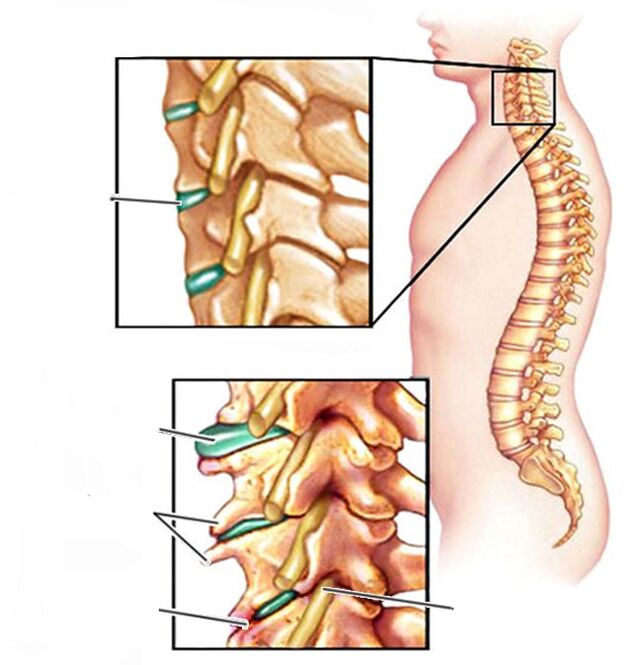The diagnosis of cervical osteochondrosis is made on the basis of simple tests - X-rays. An integrated approach to the treatment of cervical osteochondrosis is needed to reverse the disease.
An integrated approach to the treatment of cervical osteochondrosis is needed to reverse the disease.
Why does cervical osteochondrosis appear?

There are several localizations of pain: neck, head, shoulders. Weakened neck muscles lead to the development of osteochondrosis. Some neck muscles are constantly tense due to improper posture, immobility and unnatural postures, while others spend a lot of time at rest. Adapts to irrational load at the expense of spinal health. The following changes are noted in cervical osteochondrosis:
- impaired blood and lymph flow;
- malnutrition of the connective tissue of the intervertebral discs;
- instability of the position of vertebral bodies relative to each other.
Gradually the structures of the vertebrae and discs are destroyed. This process is irreversible, so you should take care of your health in a timely manner and immediately undergo treatment for symptoms of cervical spine osteochondrosis without delay. Reasons include:
- neck injuries;
- excess weight;
- connective tissue dysplasia;
- poor nutrition, insufficient water intake.
Osteochondrosis of the cervical spine: symptoms
Main symptoms (vertebral):
- Pain. There may be constant pulling, or while lying in a restless position, the neck may appear in the post-static period. There is acute pain (lumbago) that makes the patient immobile for a short time;
- Torticollis or a difficult movement. Turning or bending the head is sometimes so painful that the person finds a comfortable position where the pain is minimal and tries to stay inside;
- Muscle tension, stiffness, feeling of heaviness;
- Grinding of the spine while turning the head. Extravertebral symptoms of cervical osteochondrosis (involving nerves and surrounding tissues);
- Inflammation of the muscles;
- With headache, migraine, dizziness, sometimes nausea and vomiting;
- Pain in the back of the head, increased intracranial pressure, severe headache; Such symptoms sometimes appear so clearly that the expression "head osteochondrosis" has taken root among patients. Clearly, headache is only a secondary manifestation of pathological changes in the skeletal system, and it is correct to speak of the cervix, not of the head osteochondrosis;
- Sensory disorders: hearing and vision impairment, speech, tinnitus due to malnutrition in the brain;
- Pain in the clavicle, arms up to the palms;
- Vibration and chills in neck and arms, sometimes numbness in fingers;
- Limit the range of motion of the arms (perhaps on one side).
Dangerous consequences of cervical osteochondrosis: treatment is mandatory!
If the degenerative changes do not stop, the following can be added to osteochondrosis:
- radicular pain due to compressed nerves coming from the spine;
- protrusions and hernias that compress the spinal cord and cause complete paralysis;
- cervicocranialgia (cervical migraine, dystonic stage of vertebral artery syndrome);
- formation of osteophytes in the vertebrae.
Methods of treatment of cervical osteochondrosis of the spine
It is impossible to treat this disease with drugs. Pain syndrome can be relieved only with analgesics. However, there are always side effects, so it is recommended to use them only in extreme cases. Symptoms and treatment of cervical spine osteochondrosis vary from patient to patient and require an individual approach.
Doctors have a rich arsenal of advanced technology at their disposal; can choose the most effective and efficient one. It is effective in the treatment of cervical osteochondrosis and its manifestations:
- Traction on the DRX robot - restores the correct position of the vertebrae without the risk of injury;
- shock wave therapy - improves blood and lymph flow to the affected area, restores metabolic processes, relaxes muscles;
- interstitial electrical stimulation - fights the complications of osteochondrosis, relieves pain caused by inflammation of the compressed nerve;
- HILT - laser therapy that immediately relieves pain.
The next step in the treatment of symptoms of cervical osteochondrosis is the restoration of blood supply, consolidation of the correct position of the vertebrae. Rehabilitation can consist of several sessions and includes physiotherapy, manual therapy and the use of modern equipment. The more accurately the patient follows the recommendations of specialists, the more effective the technique. The last stage is the patient's area of responsibility:
- lifestyle and nutrition improvement;
- regular exercise therapy;
- active life position and optimism.























